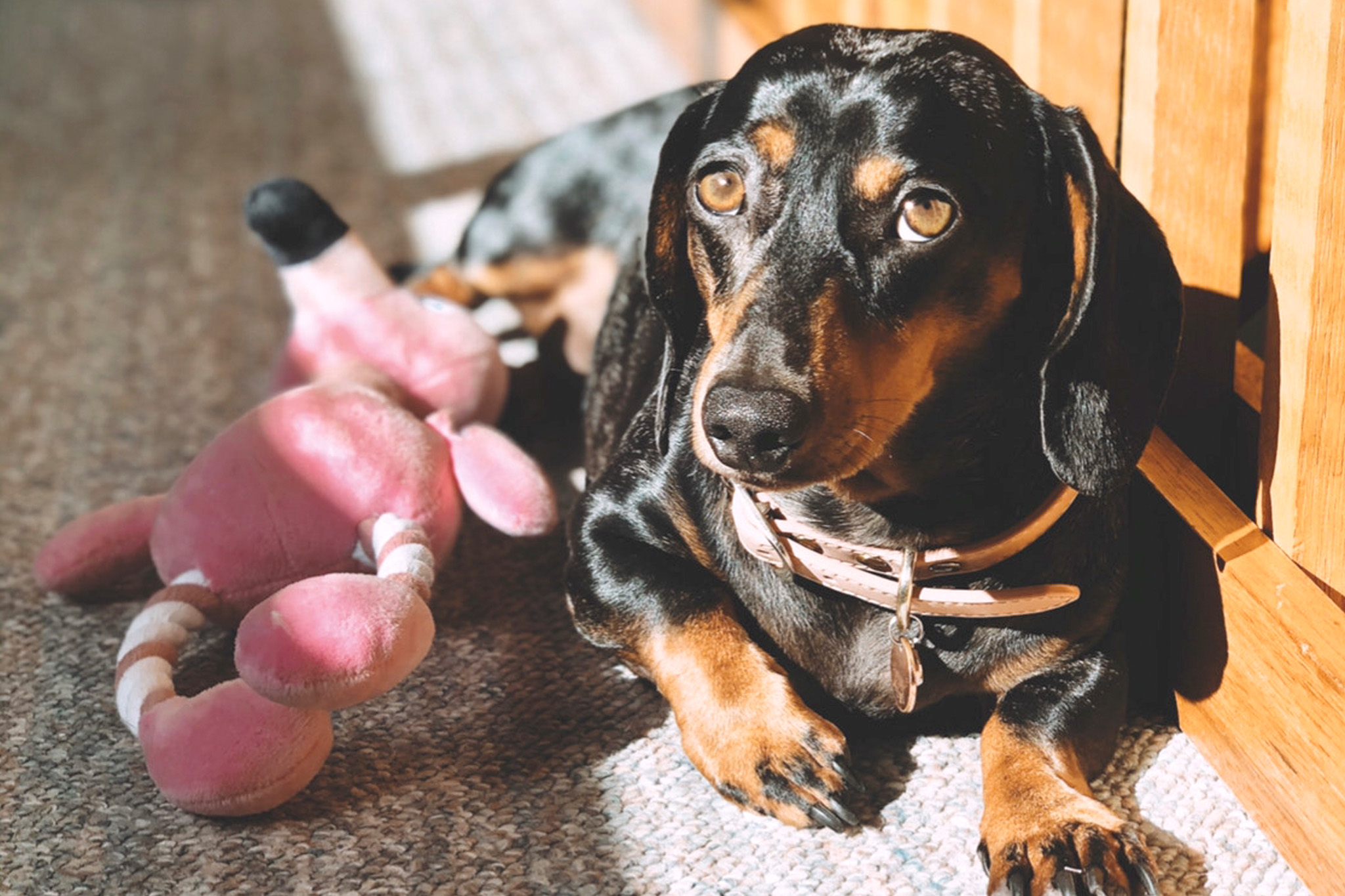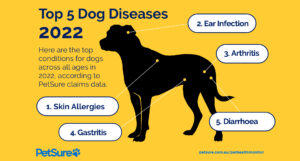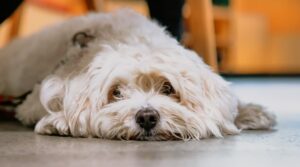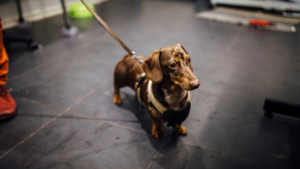Miniature Dachshund| Traits | training | Typical health problems
This section outlines Miniature Dachshund traits, training and typical health problems.
Miniature Dachshund | Breed highlights
| Breed: | Miniature Dachshunds, Dachies, Doxins or Sausage Dogs as they are also known, are a small breed, recognisable by their long, low-to-the-ground bodies, short, muscular legs, and droopy ears. |
| Coat type: | Miniature Dachshunds can be smooth with short fur that sits close to the skin, wire-haired with a coarse coat. or long-haired. |
| Shedding: | Long-haired Miniature Dachshunds shed the most, while smooth and wire-haired varieties shed the least. |
| Grooming: | Each variety of coat has its requirements. Short-haired Dachshunds need brushing weekly, while long-haired Dachshunds require daily brushing. Wire-coated Dachshunds need brushing a couple of times a week and will need their undercoat removed twice a year. |
| Activity level: | Moderate – 30 minutes of walking a day is recommended. |
| Apartment friendly: | Yes. |
| Small children: | Miniature Dachshunds may be suitable for families with small children. |
| Other dog friendly: | The breed can be receptive to other dogs if introduced properly. |
What type of breed is a Miniature Dachshund?
Miniature Dachshunds and Standard Dachshunds are the same breed of dog; the main difference is their size. Both Miniature and Standard Dachshunds belong to the hound family group of dogs.
History of Miniature Dachshund
Originating in Germany at least 500 years ago, the Dachshund became a hunter’s companion, having been developed to flush out burrow-dwelling animals. Their long and low bodies enabled the breed to follow animals like foxes or badgers into their lairs and to dig their way out with strong paddle-like paws. The breed takes its name from the German word for badger: Dachs, while Hund in German means dog. Miniature Dachshunds were also bred for hunting, although their prey were smaller animals like rabbits..
Miniature Dachshund appearance and characteristics
Miniature Dachshunds stand up to 15 centimetres tall and weigh up to 5 kilograms. Standard Dachshunds stand up to 23 centimetres tall and weigh up to 15 kilograms.
Dachshunds – Standard or Miniature – have long backs, short legs, and broad chests. The muzzle is elongated, and the ears are floppy. Tails are long and straight with a slight curve.
Dachshunds may be black, deep brown, grey or fawn with tan or brindle.
Miniature Dachshund personality and temperament
Dachshunds are intelligent dogs and, despite their small stature, come with big, bold personalities. Although the breed is highly trainable, thanks to its bright mind, Dachshunds do have a stubborn streak. Obedience training and dog handling experience is needed to bring their strong personalities into line.
Thanks to its lineage, the breed is quite fearless – a trait at odds with its size. While not aggressive, if threatened, Dachshunds will defend themselves. They’re natural hunters that will often kill anything smaller than them eg guinea pigs, birds etc . Generally, the breed gets along well with other animals and children; however, noise or energetic play can upset a Dachshund, causing it to react aggressively if it feels threatened.
Miniature Dachshund traits
Dachshunds are territorial, and although small, the breed does make a good watchdog; Dachshunds will bark to alert the household to the presence of others. Although this trait may seem ideal to those away from home, Dachshunds are highly social and prefer to be with others. A bored Dachshunds may reveal its distress through destructive behaviour like vigorous digging if left to its own devices.
Dachshunds are moderately energetic and requires 30 minutes of walking daily on average. However, diet needs consideration. The breed has an insatiable appetite and will employ any trick in the book to extract extra food or treats from their owners. While it is tempting to give in, overfeeding leads to weight gain, exacerbates their already problematic spine.
Miniature Dachshund Lifespan
Healthy Dachshunds – Standard or Miniature – can live between 12 and 16 years
The dos and don’ts of caring for a Miniature Dachshund
Do: Groom your Dachshund according to its coat type. Brush Smooth-haired Dachshunds every few days and bathe once a month. Long-hair Dachshunds need daily brushing, regular fur trimming and bathing at least once a month. Wire-haired Dachshunds need regular brushing and bathing at least once a month, and their undercoat needs removing using a special brush up to four times a year.
Don’t: Avoid regular paw and claw checks, regardless of the type of Dachshund, these are essential. Aim to trim nails monthly or sooner if you can hear them clicking. Petsure’s Masterclass provides a how-to video guide for acquiring this skill.
Do: Keep Dachshunds on a lead when walking. The breed is known to become easily distracted, has little to no road sense, and doesn’t always respond to commands.
Don’t: Let your Dachshundjump on and off furniture. Jumping from a height can injure their spine.
Common conditions for Miniature Dachshund
| Conditions | Symptoms can include~ | Highest cost for a single treatment* |
| Allergic skin disorder | · Scratching, biting or rubbing the skin · Signs of irritation including red skin, scabs, bleeding, pustules or weeping · Hair loss, flaky skin, texture changes, lumps or an unusual or unpleasant smell | $5,335 |
| Gastrointestinal (tummy) problems | · Diarrhoea, vomiting or constipation. · Blood or mucous in stool/vomit. · Increased frequency/urgency passing stool. · Weight loss. · Loss of appetite and interest in food. · May seem more tired than usual. | $ 5,170 |
| Intervertebral disc order | · Pain · Reluctance to walk · Inability to walk/paralysis · Loss of bladder/bowel control | $16,928 |
| Ear Conditions –including infections and allergies | · Scratching, rubbing, or pawing at one of both ears. · Head shaking · Odour or discharge from the ears · Ears may be red or warm to the touch | $1,674 |
| Lameness | · Limping on affected limb/s · Reluctance to run/play · Swelling/heat on affected limb/joint | $5,228 |
Disclaimer: Reimbursement for these claims would be subject to limits, such as annual benefit limits or sub-limits, benefit percentage, applicable waiting periods and any applicable excess. Cover is subject to the policy terms and conditions. You should consider the relevant Product Disclosure Statement or policy wording available from the relevant provider.
* Please note that the values calculated are based on all claims for that condition and medically related conditions in each calendar year.
Types of pet insurance from PetSure
| Policy type | Policy description |
| Accidents | This product provides cover for specified accidental injuries up to an annual policy limit. Most policies will reimburse a stated Benefit Percentage that is typically 80% of eligible vet bills. Some condition sub-limits may also apply, with all annual limits resetting each year when the policy is renewed. It’s important to know that only defined accidents as listed in the policy’s Product Disclosure Statement will be covered (other conditions will not be covered). More information on what is typically covered and not covered in our find a policy page. |
| Basic care | This product provides limited cover for both specified accidental injuries and illness conditions, with a stated Benefit Percentage that can range from 60-90%. Treatments and medications for eligible conditions are typically covered subject to the applicable policy limits. Claimable conditions have an annual condition limit , meaning once the condition limit (subject to the annual benefit limit) has been reached in an annual policy period, costs relating to that condition will need to be covered entirely by the policyholder. However, annual benefit limits and applicable annual condition limits reset on renewal each year. More information on what is typically covered and not covered in our find a policy page. |
| Comprehensive / Accident and Illness | This product provides comprehensive cover for both specified accidental injuries and illness conditions, with a stated Benefit Percentage that will typically range from 70-85%. You can claim up to an annual maximum limit each year, which resets on renewal. Sub-limits for certain items may also apply. More information on what is typically covered and not covered in our find a policy page. |
Insurance products are issued by The Hollard Insurance Company Pty Ltd ABN 78 090 584 473, AFSL 241436 (Hollard) and/or PetSure (Australia) Pty Ltd ABN 95 075 949 923, AFSL 420183 (PetSure) (from 8 May 2023 only), administered by PetSure and promoted and distributed through their authorised representatives and distribution partners.
Any advice provided is general only and does not take into account your individual objectives, financial situation or needs. Cover is subject to the policy terms and conditions. Please consider the Product Disclosure Statement (PDS) to ensure this product meets your needs before purchasing, or choosing to continue with the product. PDS and Target Market Determination available on our partners’ websites. Meet our partners at petsure.com.au/partners.
Pet insurance can help by covering a portion of the eligible vet bill if the unexpected happens. Because it is difficult to predict the costs of veterinary care, it can help to have measures in place to help prepare for the unexpected. Check out our partner network and explore our policy tools to find a pet insurance policy.
Not all conditions or items are covered by Pet Insurance. Refer to the applicable Product Disclosure Statement for information about coverage and exclusions.
Frequently Asked Questions
The most common health problems with Miniature Dachshunds:
· Intervertebral disc disease
· Patella Luxation
· Hip Dysplasia
· Obesity
· Eye problems – progressive retinal atrophy
· Seizures
All dog breeds chew, particularly as puppies, when they are teething. Dachshunds are notable because they have powerful jaws and can destroy and potentially consume a rubber toy within moments. Chewing behaviours may be displayed in response to separation.
Petsure’s PetHealth Monitor 2022 ranks Miniature Dachshund as the 4th most popular breed.
References
https://en.wikipedia.org/wiki/Dachshund
https://www.australiandoglover.com/2015/10/dachshund.html
https://www.purina.co.uk/articles/dogs/health/symptoms/dachshund-health-problems
https://www.hillspet.com.au/dog-care/dog-breeds/dachshund
https://perfectpets.com.au/pets/dogs/dog-breeds/dog-breeders/dachshund
Pet insurance can help by covering a portion of the eligible vet bill if the unexpected happens. Because it is difficult to predict the costs of veterinary care, it can help to have measures in place to help prepare for the unexpected. Check out our partner network and explore our policy tools to find a pet insurance policy.
Not all conditions or items are covered by Pet Insurance. Refer to the applicable Product Disclosure Statement for information about coverage and exclusions.



 Fact checked
Fact checked





